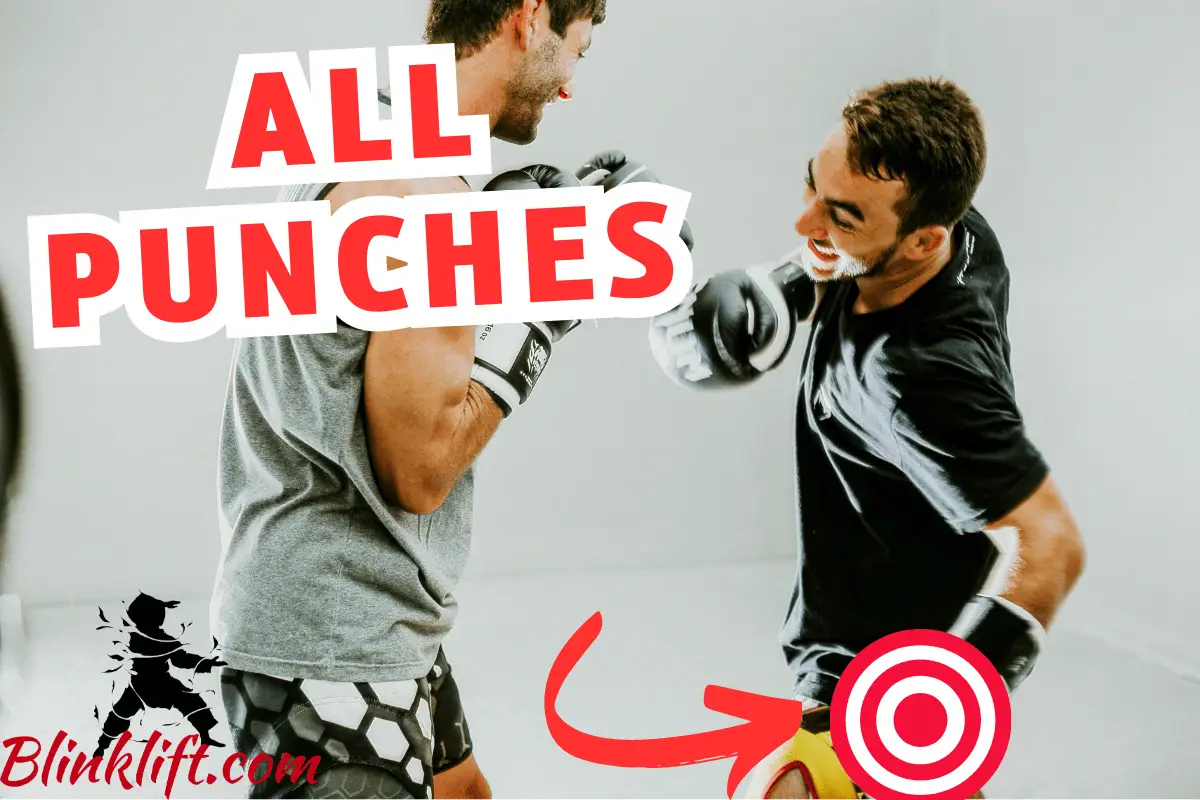Punching is a massive part of many martial arts, including Muay Thai, aka Thai Boxing. So if you’re learning it, you must learn the basic punches, as they’ll make you a much better fighter.
This article is going to be about all the basic punches in Muay Thai and how to use them properly and aggressively. You’ll be able to start using them to hit your opponent either in his face or body—and inflict a lot of damage—after you finish reading this article.
Before we dive in, I want you to understand the importance of punches in martial arts, and more importantly, in Muay Thai. Thai Boxing is a striking-based martial art, which means that you’ll learn to kick and punch.
Punching and kicking are the source techniques of many martial arts. Essentially, if you know to punch fiercely, you’ll have no issues facing people on the street and defending yourself properly.
So now that you know how important knowing to punch is—let’s dive into the first type of punch you must learn in Muay Thai: the Jab.
#1 – Jab
The first type of punch you want to learn is the Jab. This is the type of punch that will cause the least amount of damage. However, it’s also the one you’ll use the most – for many purposes, including attacking, defending, and even countering.
The Jab is also the type of punch that starts most combinations you’ll use in Thai Boxing. For instance, the 1-2, which is one of the most popular striking combinations in the world of martial arts, starts with a Jab.
The Jab is a punch you’ll throw with your weak hand (if you’re right-handed, you’ll use it with your left hand.) It’s the weakest punch because it’s much more difficult to generate power with it. For example, you can generate more force with the hook, which is another type of punch, using your hips.
Execution
To throw the jab, extend your lead hand forward in a straight line, rotating your shoulder and hips slightly to generate power. Your lead foot should pivot slightly, and your back hand should remain to guard your face.
It’s critical you step forward when throwing the jab, or else, you won’t be able to generate a whole lot of force. Therefore, I would encourage all of you to start slowly and amp up the pace once you notice your technique is on point.
It’s the simplest punch to learn to use properly, making it the one you want to learn first, which is why it’s listed as #1.

Read more about the Jab and how to master it by following this link!
#2 – Cross
The next type of punch we’ll review is called the Cross, aka the straight punch. You’re going to throw it with your dominant hand, making it a punch you can generate more force with.
The Cross is one of the most important punches in the history of striking-based martial arts. You’ll learn it in every striking-based martial art you’ll learn, including Muay Thai, MMA, Boxing, Kickboxing, and even Karate and Kung fu.
Once you know to use the jab and cross together, you’ll open up so many opportunities to attack your opponent. For instance, one of the best combinations you’ll learn is the Jab–Cross–Kick. You can cause extreme amounts of damage with it, making this punch critical to learn and understand.
Execution
Execution: To throw the cross, rotate your hips and shoulders explosively while extending your rear hand straight forward. Pivot your rear foot to generate power and transfer your body weight into the punch. Keep your lead hand guarding your face during the strike.
I want you to emphasize using your hips and feet to generate more force. This is the most important part of this punch, which you can perfect by ensuring you’re generating sufficient amounts of momentum using your body.
If you simply throw the Cross without using your lower body to assist in generating more power, you won’t be able to cause almost any amount of damage using it.
If you want to read more about the Cross, follow this link!
#3 – Hook
And now, for #3, we have the Hook. This, together with the next type of punch, is what people like to name “a Knockout Punch.” What do they mean by that?
Typically, the Hook is the finishing blow because of one primary reason; it’s a side punch. The side of the face is more sensitive to damage. Therefore, if you get hit on the side of your face, let’s say by a Hook, you’ll experience more pain and more damage than if you were to get hit by a Cross or a Jab.
Therefore, you’ll say many knockout blows with the Hook. So that’s a fantastic reason for you to invest time into learning it. Let’s see how its execution goes.
Execution
To throw the hook, pivot your lead foot and rotate your hips and shoulders simultaneously. Bend your elbow at a 90-degree angle and bring your lead hand in a semi-circular motion, aiming to strike the side of your opponent’s head or body. Rotate your knuckles to face outward upon impact for maximum power.
You can execute the hook either with your dominant or weak hand, it doesn’t matter. In fact, it’ll be worth it to work on throwing the Hook with both sides, as that’ll make you a more dynamic and capable fighter.
Lastly, you can combine the hook with many combinations. In boxing, the Jab–Cross–Hook is one of the best offensive combinations for finishing fights. Likewise, you have the Body Hook–Uppercut to finish the fight.

The Hook is a strike you want to invest time in learning. Luckily, I have an entire article that will guide you to Hook perfection, which you can read by following this link!
#4 – Uppercut
#4 is one of my personal favorites: the Uppercut. If you’re reading this article, it’s more than likely that you’ve heard of it prior to reading this article. And still, I’ll review it from start to finish, so to clear up any misconceptions about it while clarifying its proper execution.
The Uppercut, similar to the Hook, is considered a Knockout Punch. That means that you’ll see many finishing blows with it, whether it’s in Boxing, MMA, Kickboxing, or Thai Boxing. The reason for that is that it’s a lateral punch, which comes from down to above.
You’ll typically hit your opponent’s chin when throwing the upper, which is much more sensitive than the front of the face. If you can recall, I’ve mentioned that the side of the face is also fairly sensitive. Similar to that, the chin and jaw are also more sensitive spots to hit.
Execution
To throw the uppercut, transfer your body weight onto your lead foot while bending your knees slightly. Rotate your hips and shoulders, driving your lead hand in an upward motion toward your target. Extend your arm from a bent position, aiming to strike the chin or body of your opponent.
Read more about the Uppercut and how to perform it correctly (if you’re serious about your training) by following this link.
#5 – Overhand Punch
The next type of punch we’ll review, which is one that’s specifically taught in Muay Thai—is the Overhand Punch. It’s a less popular one, especially if you’ve followed Boxing or MMA prior to becoming a Muay Thai disciple.
What makes this punch special is the fact that you can hit your opponent above his guard. So you throw it from above and strike the opponent in the middle of his face. If possible, you can hit either the side or any other part of his face that’s exposed to you.
Indeed, it has more success chances considering the fact that you’re throwing it above his guard. The Overhand Punch is difficult to defend against. Likewise, you’ll be capable of generating a lot of force with it, as it’s one of the hardest-hitting punches in the world of Thai Boxing.

Execution
To throw the overhand punch, initiate the movement by rotating your hips and shoulders. Instead of throwing the punch straight, loop your rear hand in an arcing motion over your opponent’s guard. Imagine throwing the punch from outside of your opponent’s field of vision. The punch should come down and across, striking the target with the back of your hand or knuckles.
A great way to think about throwing this punch is faking a hit to the body and then going for the overhand. You’ll be able to confuse your opponent by leaning forward and even ducking a bit, which will help you generate more force.
Keep in mind that you want to keep your style as dynamic as possible. Therefore, it’ll be worth it to invest time into learning combinations using the Overhand Punch, which can be lethal when executed properly. For example, a basic one would be Jab–Overhand Punch.
You can learn more about the Overhand Punch and how to avoid making the common mistakes most Muay Thai fighters make with it—by following this link.
#6 – Straight Elbow
The sixth, and last, type of punch, which is more of a strike, we’ll review—is the Straight Elbow. It’s one of my favorite ones because you’ll be able to cause so much damage when you hit this strike. Likewise, it allows you to cause damage to your opponent from a closer range, which can be effective and useful if you’re in a close-quarters situation.
The Straight Elbow can be used both on the opponent’s head or body. If you perform it well enough, you’ll be able to generate extreme amounts of damage using it, especially from a closer range.
Let’s dive into its execution:
Execution
To perform the straight elbow, step forward with the same-side foot as your striking elbow. Simultaneously, thrust your elbow forward in a straight line, driving it towards your target. Rotate your hips and shoulders for added power. The strike should be delivered with the sharp point of your elbow.
Emphasize rotating your hips and shoulders to add more power. Without this rotation, it’ll be hard to generate a lot of force.
Read more about the Straight Elbow by following this link!
Final Words
These are the basic type of punches you must learn to consider yourself a Muay Thai disciple. Without these core techniques, it’ll be difficult to face people either on the street, in self-defense, or in the martial arts gym.
Therefore, learning and perfecting them—will be key to becoming a solid Muay Thai fighter.
And that’s it for this article. Your next step is to practice each technique alone until you feel comfortable with it. So if you’re serious about learning to punch fiercely, bookmarking this article is a great idea, as it’ll allow you to have all the information you need in easy access.
You can also sign up for our Email Newsletter to keep up with our blog posts and gain access to free martial arts/self-improvement courses!
Here are other articles you’d enjoy reading:
How to Perfect Your Muay Thai Fighting Stance – Guide
9 Amazing Benefits Muay Thai Training Will Give You
Is Muay Thai Effective? 3 Real Examples!
Should You Learn Muay Thai? (Not What You Think)

